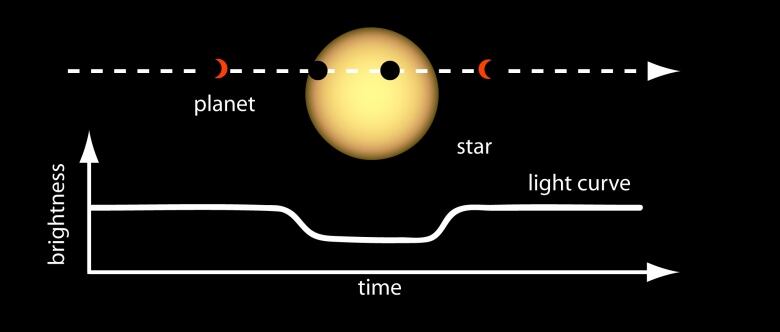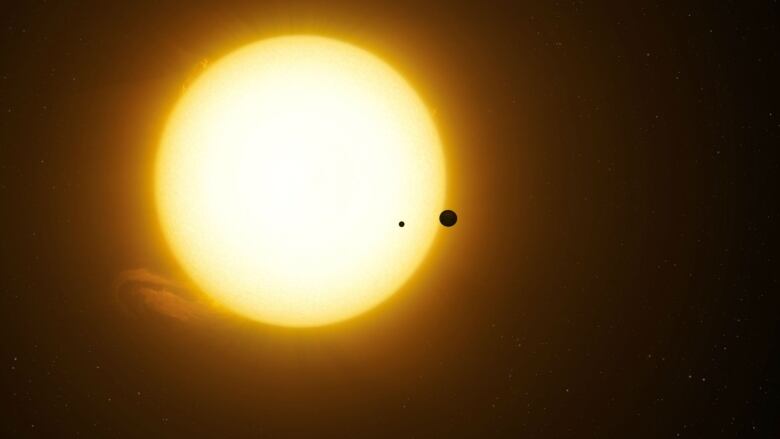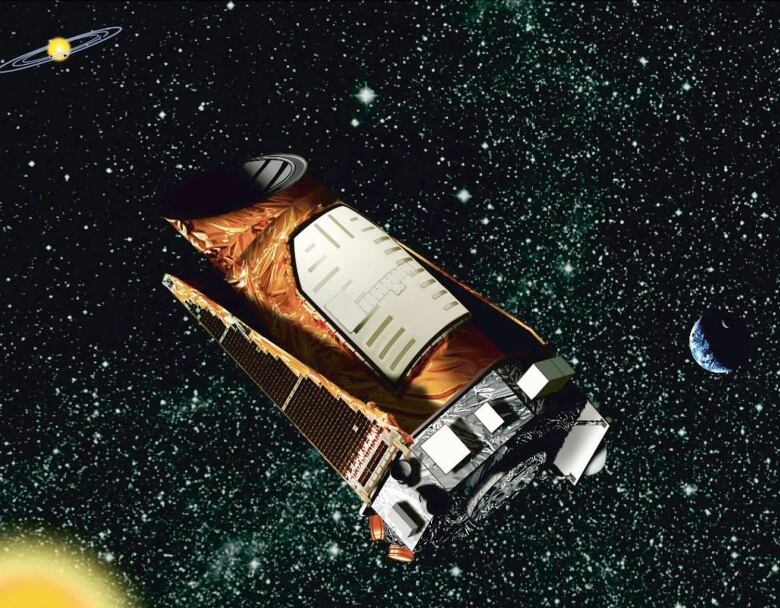Scientists find more evidence of 1st moon orbiting an exoplanet
'We're unable to find any other single hypothesis which can explain all of the data we have' researcher

There have been almost 3,800 exoplanets confirmed, diverse worlds orbiting stars light-years from Earth. But the one thing that astronomers have yet to confirm is a moon orbiting one of these planets.
A new study published in Science Advances on Wednesday, however, has added more support to the hypothesis that there is a moon orbiting one particular exoplanet. The authors do caution that more data is needed before they can definitively confirm an exomoon.
The planet is Kepler 1625b, a Jupiter-sized planet orbiting a nine-billion-year-old, sun-like star (Kepler 1625) roughly 8,000 light-years away.
There are several ways in which to discover exoplanets, the most popular being the transit method. This is when a telescope, such as exoplanet-hunter Kepler, looks for any dips in a star's brightness. Such dips could be indicative of something crossing in front of it. Followup observations are then conducted in order to either confirm or reject the presence of an exoplanet.

And that's just how Kepler 1625b was found. Since its discovery, a few planetary scientists believed that there was a second dip in the star's brightness, raising the possibility of an exomoon that could be trailing behind it (or in some cases, passing in front of it).
Researchers of the new paper, AlexTeachey and David Kipping, used observations from Kepler three in total and added about 40 hours of their own observations using Hubble, which is four times more accurate than Kepler.
They believe that there is a strong signal in the data to add to the hypothesis of an exomoon.
"Our analysis of the new light curve reveals two substantial anomalies," Kipping said. "The first is that the planet appears to transit one and a quarter hours too early: that's indicative of something gravitationally tugging on the planet. The second anomaly is an additional decrease in the star's brightness after the planetary transit has completed."
These findings suggest that there is a Neptune-sized moon transiting, or crossing, in front of the star, just as the planet itself does.

"We've tried our best to rule out other possibilities such as spacecraft anomalies, other planets in the system or stellar activity," Kipping said. "But we're unable to find any other single hypothesis which can explain all of the data we have."
Still, they say that more observations are needed.
"We are urging caution here," Teachey said. "The first exomoon is obviously an extraordinary claim, and it requires extraordinary evidence."
But more observations could take some time: Kepler 1625b takes 247 days to orbit its star, which means scientists need to wait almost a year before making just one observation.
Still, one more transit could be enough.
"If we see two events agreeing with our prior prediction, I think we have a very closed case on this system," Kipping said. "So maybe just one more transit [is needed]. If we don't see it, then there is a fraction of our models which actually allow that still to happen. And it would have to go from there."
The next time the planet will transit the star is in May 2019.
And if the moon is confirmed with subsequent observations, it would be the first known moon outside of our solar system.
Large moon
Kipping and Teachey surveyed 300 exoplanets before finding a signal in Kepler 1625b that looked like it could be an exomoon.
That may seem somewhat surprising, since the star is so far away (there had been earlier estimates that it was 4,000 light-years away, but further data finds that it is twice as distant).

However, most of the exoplanets Kepler have found are warm and close to their star, which Kipping said isn't an ideal place to find a moon. But Kepler 1625b is far enough from the star that a moon could potentially form and also be detectable.
One of the surprising things, however, is just how large the moon is.
Researchers said that it's important to consider the masses of the two objects. In the case of the moon, it would be roughly 1.5 per cent of the planet's size, and that if it formed out of material that surrounded the planet, it is plausible to end up with such a large moon, though this would be at the larger end of that scale.
And while the jury's out on claiming definitively that Kepler 1625b has an exomoon, it's something that exoplanet hunters are looking forward to confirming within the coming years.
"It's exciting to see the hunt for the first exomoon continue," said Canadian exoplanet researcher Sara Seager, an astrophysicist and planetary astronomer at MIT who was not involved in the study.
"And with what would be a shockingly large moon, about the size and mass of Neptune."
There's also the possibility that NASA's newest exoplanet instrument, the Transiting Exoplanet Survey Satellite (TESS), will hasten the search for exomoons.
The confirmation will not only be an exciting and groundbreaking discovery, it will also shed light on our own solar system.
"I would always say is that every time we were looking out at these exoplanets, we're really learning more also about the commonality of our own solar system," Teachey said.
"We have, we think, a pretty good sense of how things formed around here, and when we started looking at exoplanets we started thinking maybe we didn't have all the answers in terms of how solar systems form."












_(720p).jpg)


 OFFICIAL HD MUSIC VIDEO.jpg)
.jpg)



























































































